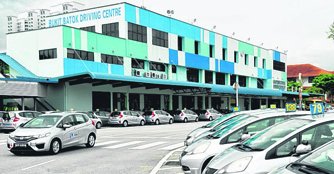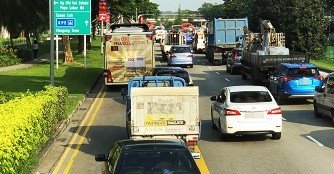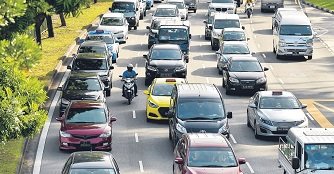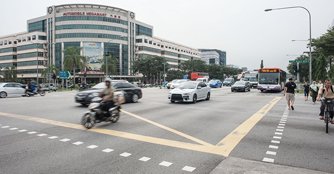Secrets about obtaining the driver's licence and its history
21 Feb 2018|113,421 views
 |
That piece of card that finally makes us adults, legal behind the wheel, our driver's licence. Now, obviously the driver's licence did not always look like this, no. It was anything but a simple plastic card.
The red booklet
The very first kind of driver's licence issued by Singapore, which looks very much like our present-day passports, except with, you know, driving stuff instead of travelling stuff.
These little booklets didn't last too long as they were replaced in the 1970s with the exact date lost in time. The replacement was somewhat underwhelming though, the infamous green thing.
The laminated paper
It resembles the modern-day Provisional Driving Licence (PDL), basically a green piece of paper. Probably the most unreliable amongst the three different types of driver's licences. It wears out easily, tears easily, and would most likely be obliterated on a rainy day.
Topping it all off, it also had the all-so burdensome chore of renewing it every one or three years. Not to mention the long waiting line for the renewal. Many found it a hassle, just awful.
The present
The current driver's licence we own today was introduced back in 2003. Owners of the older licence were instructed to get theirs replaced with the new one. To the delight of many, it was also, wait for it… permanent!
The simplicity of a photocard that could most of the time substitute as an NRIC was the perfect design. Not sure why they couldn't come up with this idea back in the 1990s or maybe even the 1980s. It will be a long time before this design is replaced, if ever.
A little note, in the year of 2015 when Singapore turned 50, every driver's licence issued had an 'SG50' stamp printed on the bottom right of the card (like the one above). Quite a unique feature for those who obtained or replaced their licence in 2015, a limited edition if you will.
Gossips, beliefs and rumours
As an aspiring driver, you will often hear about auspicious and ominous timings to book your driving test or which driving centre has the easiest test routes et cetera. These discussions have been around for ages and we should continue this tradition for the years to come.
Morning sessions
The rush hour from 8:00am to 10:00am is often avoided due to the number of cars on the road. Some would consider this a good thing though.
Like a comment I've once heard, "Just follow behind a vehicle and you'll be safe. Better than being the first in traffic absorbing all the pressure," which, to an extent, is rather true. To each their own, I suppose.
Next comes the 10:00am to 12:00pm period. Traffic is usually smooth during this period, which is why the time slots in between are the most coveted.
Rumour has it that this is the time where the passing rate is at its highest, too. Many test candidates, after acing their tests, have told the tale of how effortless it was. If you're looking to book your Traffic Police test date, you won't want to miss out on this time slot.
Afternoon sessions
The lunch rush hour from 12:00pm to 2:00pm is quite a congested period too, due to office personnel driving to nearby coffeeshops or malls for lunch.
Test routes are also usually surrounded by offices and warehouses, which means there will be tons of heavy vehicles for you to worry about as well. You will not want to be sabotaged by an inconsiderate driver rushing for his lunch, cutting you off and such.
Then again, like during the morning peak hours, this could play to your advantage instead. Another upside to this period is the lunch hour for the driving instructors. That means you have an empty circuit, a huge bonus if you ask me.
Past 2:00pm to 6:00pm is quite the ideal period, too. Lunch hour is over, and traffic becomes smooth again. Much like from the 10:00am to 12:00pm timing, many would advise that this is the best time to book your test for reasons alike. Some even say that as it draws closer to 5:00pm, testers would usually want to go home early. Do a good one, and he can easily overlook a few flaws, and you'll be street legal before you know it.
All in all, it still comes down to one's skill in order to pass the test. Relax, don't panic in tight situations, take a deep breath and remember what you were taught. Good things tend to happen more often when you stay calm.
The different driving centres
Statistics state that the Bukit Batok Driving Centre (BBDC) tends to produce higher passing rates, with a 61.7 percent passing rate on the first try, based on Class 3 (2017). Second in place would be the Singapore Safety Driving Centre (SSDC) with 53.9 percent. And lastly, the ComfortDelGro Driving Centre (CDC) at 50.7 percent.
Reason being the difference in test routes, and traffic flow. Some say that BBDC has the easiest test route amongst the three driving centres, lesser traffic and nicer Traffic Police testers.
A few have also mentioned that there is a chance that U-turns won't be tested at BBDC and CDC, while all 10 test routes of SSDC have a U-turn. Numbers don't lie, so choose your driving centre wisely. Most people choose their driving centres based on proximity anyway.
Additional fun facts
Certificate of Merit
Many new drivers are unaware of the Certificate of Merit (COM). This certificate is awarded to drivers who have, for the past three years, maintained a continuous demerit-point-free driving record. Now, this may seem like a redundant piece of paper to one who doesn't take pride in this personal achievement, but it actually comes with a hidden perk.
When awarded with the COM, you are entitled to an additional five percent discount for your car insurance. Simply show the printout of the certificate to the insurance company and they will do the necessary to get you that discount.

Some men lucky enough to receive the driver (now known as Transport Operator) vocation during their National Service go through the driving course military style.
The driving course is rather different from those you receive at the local driving centres. Most of them go through both Class 3 and 4 courses, with the test conducted on a Class 4 vehicle - the 3-Tonner (obtaining the Class 4 licence entitles you to drive Class 3 vehicles, duh).
Not the easiest task for those without any driving experience, and as you would've guessed, not too many people pass on their first attempt. A total of eight attempts are given to an individual to pass. Failing to do so will ultimately result in a revocation.
If successful in obtaining the military driver's licence, one will have to clock a total of 4,000km to be able to qualify for a conversion of licence upon his Operationally Ready Date. Depending on the different units, 4,000km may or may not be an easy goal to achieve over the span of about a year and a half.

He will also have to do the math for all trips, ensure that he hits 4,000km and submit an application for the conversion. Upon approval, a letter will be provided, which is to be taken to BBDC to retrieve the civilian licence. Rather taxing in all honesty, but hey, free driver's licence (monetary wise at least)!
Driving is a huge factor in many people's lives, and it is also a symbolic ascension into adulthood. The sweet joy of finally obtaining your licence, no more dreading to go for lessons and worrying for the tests. I'm sure many have already felt that bliss. Treasure your driver's licence because that piece of plastic card stays with you for life.
That piece of card that finally makes us adults, legal behind the wheel, our driver's licence. Now, obviously the driver's licence did not always look like this, no. It was anything but a simple plastic card.
The red booklet
The very first kind of driver's licence issued by Singapore, which looks very much like our present-day passports, except with, you know, driving stuff instead of travelling stuff.
These little booklets didn't last too long as they were replaced in the 1970s with the exact date lost in time. The replacement was somewhat underwhelming though, the infamous green thing.
The laminated paper
It resembles the modern-day Provisional Driving Licence (PDL), basically a green piece of paper. Probably the most unreliable amongst the three different types of driver's licences. It wears out easily, tears easily, and would most likely be obliterated on a rainy day.
Topping it all off, it also had the all-so burdensome chore of renewing it every one or three years. Not to mention the long waiting line for the renewal. Many found it a hassle, just awful.
The present
The current driver's licence we own today was introduced back in 2003. Owners of the older licence were instructed to get theirs replaced with the new one. To the delight of many, it was also, wait for it… permanent!
The simplicity of a photocard that could most of the time substitute as an NRIC was the perfect design. Not sure why they couldn't come up with this idea back in the 1990s or maybe even the 1980s. It will be a long time before this design is replaced, if ever.
A little note, in the year of 2015 when Singapore turned 50, every driver's licence issued had an 'SG50' stamp printed on the bottom right of the card (like the one above). Quite a unique feature for those who obtained or replaced their licence in 2015, a limited edition if you will.
Gossips, beliefs and rumours
As an aspiring driver, you will often hear about auspicious and ominous timings to book your driving test or which driving centre has the easiest test routes et cetera. These discussions have been around for ages and we should continue this tradition for the years to come.
Morning sessions
The rush hour from 8:00am to 10:00am is often avoided due to the number of cars on the road. Some would consider this a good thing though.
Like a comment I've once heard, "Just follow behind a vehicle and you'll be safe. Better than being the first in traffic absorbing all the pressure," which, to an extent, is rather true. To each their own, I suppose.
Next comes the 10:00am to 12:00pm period. Traffic is usually smooth during this period, which is why the time slots in between are the most coveted.
Rumour has it that this is the time where the passing rate is at its highest, too. Many test candidates, after acing their tests, have told the tale of how effortless it was. If you're looking to book your Traffic Police test date, you won't want to miss out on this time slot.
Afternoon sessions
The lunch rush hour from 12:00pm to 2:00pm is quite a congested period too, due to office personnel driving to nearby coffeeshops or malls for lunch.
Test routes are also usually surrounded by offices and warehouses, which means there will be tons of heavy vehicles for you to worry about as well. You will not want to be sabotaged by an inconsiderate driver rushing for his lunch, cutting you off and such.
Then again, like during the morning peak hours, this could play to your advantage instead. Another upside to this period is the lunch hour for the driving instructors. That means you have an empty circuit, a huge bonus if you ask me.
Past 2:00pm to 6:00pm is quite the ideal period, too. Lunch hour is over, and traffic becomes smooth again. Much like from the 10:00am to 12:00pm timing, many would advise that this is the best time to book your test for reasons alike. Some even say that as it draws closer to 5:00pm, testers would usually want to go home early. Do a good one, and he can easily overlook a few flaws, and you'll be street legal before you know it.
All in all, it still comes down to one's skill in order to pass the test. Relax, don't panic in tight situations, take a deep breath and remember what you were taught. Good things tend to happen more often when you stay calm.
The different driving centres
Statistics state that the Bukit Batok Driving Centre (BBDC) tends to produce higher passing rates, with a 61.7 percent passing rate on the first try, based on Class 3 (2017). Second in place would be the Singapore Safety Driving Centre (SSDC) with 53.9 percent. And lastly, the ComfortDelGro Driving Centre (CDC) at 50.7 percent.
Reason being the difference in test routes, and traffic flow. Some say that BBDC has the easiest test route amongst the three driving centres, lesser traffic and nicer Traffic Police testers.
A few have also mentioned that there is a chance that U-turns won't be tested at BBDC and CDC, while all 10 test routes of SSDC have a U-turn. Numbers don't lie, so choose your driving centre wisely. Most people choose their driving centres based on proximity anyway.
Additional fun facts
Certificate of Merit
Many new drivers are unaware of the Certificate of Merit (COM). This certificate is awarded to drivers who have, for the past three years, maintained a continuous demerit-point-free driving record. Now, this may seem like a redundant piece of paper to one who doesn't take pride in this personal achievement, but it actually comes with a hidden perk.
When awarded with the COM, you are entitled to an additional five percent discount for your car insurance. Simply show the printout of the certificate to the insurance company and they will do the necessary to get you that discount.


The Singapore Armed Forces Driver's Licence allows for the operation of military vehicles such as the 3-Tonner Military driving licence
Some men lucky enough to receive the driver (now known as Transport Operator) vocation during their National Service go through the driving course military style.
The driving course is rather different from those you receive at the local driving centres. Most of them go through both Class 3 and 4 courses, with the test conducted on a Class 4 vehicle - the 3-Tonner (obtaining the Class 4 licence entitles you to drive Class 3 vehicles, duh).
Not the easiest task for those without any driving experience, and as you would've guessed, not too many people pass on their first attempt. A total of eight attempts are given to an individual to pass. Failing to do so will ultimately result in a revocation.
If successful in obtaining the military driver's licence, one will have to clock a total of 4,000km to be able to qualify for a conversion of licence upon his Operationally Ready Date. Depending on the different units, 4,000km may or may not be an easy goal to achieve over the span of about a year and a half.


Once a military licence conversion has been approved, the driver has to head down to BBDC to retrieve his civilian licence A rather simple, albeit tedious, procedure but worth it nonetheless. The military personnel will have to record every single trip he makes. Specifically, time, start and end points, distance travelled, as well as start and end mileage.
He will also have to do the math for all trips, ensure that he hits 4,000km and submit an application for the conversion. Upon approval, a letter will be provided, which is to be taken to BBDC to retrieve the civilian licence. Rather taxing in all honesty, but hey, free driver's licence (monetary wise at least)!
Driving is a huge factor in many people's lives, and it is also a symbolic ascension into adulthood. The sweet joy of finally obtaining your licence, no more dreading to go for lessons and worrying for the tests. I'm sure many have already felt that bliss. Treasure your driver's licence because that piece of plastic card stays with you for life.
The red booklet
The very first kind of driver's licence issued by Singapore, which looks very much like our present-day passports, except with, you know, driving stuff instead of travelling stuff.
These little booklets didn't last too long as they were replaced in the 1970s with the exact date lost in time. The replacement was somewhat underwhelming though, the infamous green thing.
The laminated paper
It resembles the modern-day Provisional Driving Licence (PDL), basically a green piece of paper. Probably the most unreliable amongst the three different types of driver's licences. It wears out easily, tears easily, and would most likely be obliterated on a rainy day.
Topping it all off, it also had the all-so burdensome chore of renewing it every one or three years. Not to mention the long waiting line for the renewal. Many found it a hassle, just awful.
The present
The current driver's licence we own today was introduced back in 2003. Owners of the older licence were instructed to get theirs replaced with the new one. To the delight of many, it was also, wait for it… permanent!
The simplicity of a photocard that could most of the time substitute as an NRIC was the perfect design. Not sure why they couldn't come up with this idea back in the 1990s or maybe even the 1980s. It will be a long time before this design is replaced, if ever.
A little note, in the year of 2015 when Singapore turned 50, every driver's licence issued had an 'SG50' stamp printed on the bottom right of the card (like the one above). Quite a unique feature for those who obtained or replaced their licence in 2015, a limited edition if you will.
Gossips, beliefs and rumours
As an aspiring driver, you will often hear about auspicious and ominous timings to book your driving test or which driving centre has the easiest test routes et cetera. These discussions have been around for ages and we should continue this tradition for the years to come.
Morning sessions
The rush hour from 8:00am to 10:00am is often avoided due to the number of cars on the road. Some would consider this a good thing though.
Like a comment I've once heard, "Just follow behind a vehicle and you'll be safe. Better than being the first in traffic absorbing all the pressure," which, to an extent, is rather true. To each their own, I suppose.
Next comes the 10:00am to 12:00pm period. Traffic is usually smooth during this period, which is why the time slots in between are the most coveted.
Rumour has it that this is the time where the passing rate is at its highest, too. Many test candidates, after acing their tests, have told the tale of how effortless it was. If you're looking to book your Traffic Police test date, you won't want to miss out on this time slot.
Afternoon sessions
The lunch rush hour from 12:00pm to 2:00pm is quite a congested period too, due to office personnel driving to nearby coffeeshops or malls for lunch.
Test routes are also usually surrounded by offices and warehouses, which means there will be tons of heavy vehicles for you to worry about as well. You will not want to be sabotaged by an inconsiderate driver rushing for his lunch, cutting you off and such.
Then again, like during the morning peak hours, this could play to your advantage instead. Another upside to this period is the lunch hour for the driving instructors. That means you have an empty circuit, a huge bonus if you ask me.
Past 2:00pm to 6:00pm is quite the ideal period, too. Lunch hour is over, and traffic becomes smooth again. Much like from the 10:00am to 12:00pm timing, many would advise that this is the best time to book your test for reasons alike. Some even say that as it draws closer to 5:00pm, testers would usually want to go home early. Do a good one, and he can easily overlook a few flaws, and you'll be street legal before you know it.
All in all, it still comes down to one's skill in order to pass the test. Relax, don't panic in tight situations, take a deep breath and remember what you were taught. Good things tend to happen more often when you stay calm.
The different driving centres
Statistics state that the Bukit Batok Driving Centre (BBDC) tends to produce higher passing rates, with a 61.7 percent passing rate on the first try, based on Class 3 (2017). Second in place would be the Singapore Safety Driving Centre (SSDC) with 53.9 percent. And lastly, the ComfortDelGro Driving Centre (CDC) at 50.7 percent.
Reason being the difference in test routes, and traffic flow. Some say that BBDC has the easiest test route amongst the three driving centres, lesser traffic and nicer Traffic Police testers.
A few have also mentioned that there is a chance that U-turns won't be tested at BBDC and CDC, while all 10 test routes of SSDC have a U-turn. Numbers don't lie, so choose your driving centre wisely. Most people choose their driving centres based on proximity anyway.
Additional fun facts
Certificate of Merit
Many new drivers are unaware of the Certificate of Merit (COM). This certificate is awarded to drivers who have, for the past three years, maintained a continuous demerit-point-free driving record. Now, this may seem like a redundant piece of paper to one who doesn't take pride in this personal achievement, but it actually comes with a hidden perk.
When awarded with the COM, you are entitled to an additional five percent discount for your car insurance. Simply show the printout of the certificate to the insurance company and they will do the necessary to get you that discount.

The Singapore Armed Forces Driver's Licence allows for the operation of military vehicles such as the 3-Tonner
Some men lucky enough to receive the driver (now known as Transport Operator) vocation during their National Service go through the driving course military style.
The driving course is rather different from those you receive at the local driving centres. Most of them go through both Class 3 and 4 courses, with the test conducted on a Class 4 vehicle - the 3-Tonner (obtaining the Class 4 licence entitles you to drive Class 3 vehicles, duh).
Not the easiest task for those without any driving experience, and as you would've guessed, not too many people pass on their first attempt. A total of eight attempts are given to an individual to pass. Failing to do so will ultimately result in a revocation.
If successful in obtaining the military driver's licence, one will have to clock a total of 4,000km to be able to qualify for a conversion of licence upon his Operationally Ready Date. Depending on the different units, 4,000km may or may not be an easy goal to achieve over the span of about a year and a half.

Once a military licence conversion has been approved, the driver has to head down to BBDC to retrieve his civilian licence
He will also have to do the math for all trips, ensure that he hits 4,000km and submit an application for the conversion. Upon approval, a letter will be provided, which is to be taken to BBDC to retrieve the civilian licence. Rather taxing in all honesty, but hey, free driver's licence (monetary wise at least)!
Driving is a huge factor in many people's lives, and it is also a symbolic ascension into adulthood. The sweet joy of finally obtaining your licence, no more dreading to go for lessons and worrying for the tests. I'm sure many have already felt that bliss. Treasure your driver's licence because that piece of plastic card stays with you for life.
Thank You For Your Subscription.




























